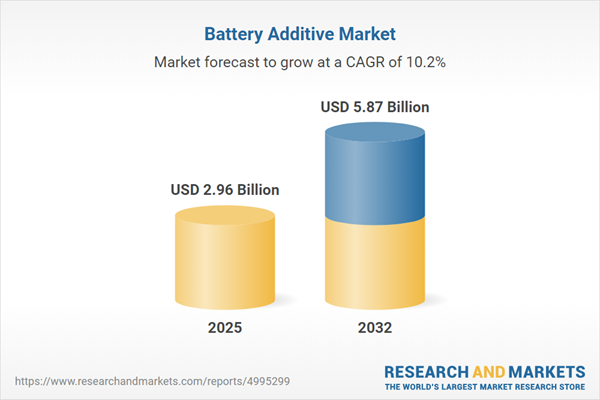Speak directly to the analyst to clarify any post sales queries you may have.
The battery additive market is transforming rapidly, driven by shifting supply chains and evolving regulatory frameworks. As energy storage needs intensify, senior professionals face rising pressure to secure dependable insights that inform procurement, ensure compliance, and empower proactive strategy within the changing global landscape.
Market Snapshot: Battery Additive Market Trends and Growth
The battery additive market is on a steady growth trajectory, guided by continuous technological development and the expanding adoption of energy storage solutions. End-use sectors such as automotive, electronics, and stationary power are catalyzing the evolution of battery chemistries and the pursuit of higher safety benchmarks. As manufacturers seek to enhance product reliability, organizations diversify their additive portfolios and sourcing channels, systematically reinforcing supply resilience. The ongoing need for infrastructure modernization, coupled with global disruptions, drives companies to prioritize adaptability. These shifts ensure that battery additives remain integral to supporting robust, future-ready energy systems across various industries.
Scope & Segmentation: Battery Additive Market
This report delivers targeted analysis for procurement and compliance decision-makers navigating a complex and rapidly adapting space. Coverage spans key categories that influence operational performance and market positioning:
- Battery Types: Examines lead acid, multiple lithium-ion chemistries—including lithium cobalt oxide, lithium iron phosphate, nickel cobalt aluminum, and nickel manganese cobalt—and nickel metal hydride batteries, focusing on how additives optimize lifecycle, reliability, and efficiency.
- Applications: Addresses automotive, consumer electronics, wearables, residential and industrial stationary storage, as well as utilities, military, telecom, commercial, and backup power, with analysis centered on additive-driven safety and performance enhancements for each sector.
- Performance Benefits: Details the roles of additives in boosting electrical conductivity, refining thermal management, and extending operational longevity across a spectrum of demanding environments.
- Forms: Considers both liquid and powder additive formats, allowing compatibility with varied production processes and scalability requirements in manufacturing operations.
- Regions: Investigates procurement strategies, regulatory expectations, and supply chain frameworks across the Americas, EMEA, and Asia-Pacific, linking localized preferences with distinct compliance mandates and regional growth opportunities.
- Leading Companies: Profiles BASF SE, Albemarle Corporation, Evonik Industries AG, Ube Industries, Shenzhen Capchem Technology, Mitsubishi Chemical Corporation, Clariant AG, Solvay S.A., LANXESS AG, and Soulbrain Co., highlighting their strategic approaches to supply continuity and partnership alignment.
Key Takeaways for Senior Decision-Makers
- Advanced battery additives provide the ability to respond swiftly to both global and regional regulatory changes, fostering ongoing compliance in evolving legal and environmental frameworks.
- Sustained innovation in materials and processes supports rapid adaptation to changing industry standards, granting companies an edge in meeting shifting customer expectations.
- Incorporating responsible sourcing and recycling practices enhances transparency and aligns organizations with circular economy initiatives while reinforcing the integrity of supply chains.
- Strategic partnerships between additive suppliers and battery manufacturers contribute to the efficient rollout of new products, shortening time-to-market as technology evolves.
- Expanding supplier diversity across different regions helps organizations manage risks related to sudden supply disruptions or regulatory shifts.
- Flexible, modular manufacturing supports efficient customization, enabling companies to meet the unique requirements of mobile, stationary, and sector-specific storage applications.
Tariff Impact on Battery Additive Supply Chains
Impending changes to U.S. tariffs in 2025 are prompting battery additive producers to reassess their supply chain structures. Industries are amending supplier contracts, reinforcing local sourcing, and planning new compliance responses to strengthen continuity in an increasingly complex trade environment.
Methodology & Data Sources
Research for this report combines comprehensive secondary analysis, sector expertise, and validated quantitative data. Findings are built from peer-reviewed studies, intellectual property reviews, exclusive data sets, and direct input from industry stakeholders, delivering a clear and reliable market overview.
Why This Report Matters for the Battery Additive Market
- Gives procurement and compliance executives powerful tools to pinpoint emerging supply and regulatory risks within evolving energy storage systems.
- Presents actionable strategies for integrating sustainable sourcing and process best practices adaptable to current and future business demands.
- Prepares organizations to navigate complex regulatory and technology shifts, ensuring ongoing performance and resilience throughout the energy value chain.
Conclusion
As regulatory requirements and technological innovations accelerate, the battery additive market presents new challenges and opportunities. This report empowers leaders with strategic insights for resilient growth and informed responses to an evolving global energy storage environment.
Additional Product Information:
- Purchase of this report includes 1 year online access with quarterly updates.
- This report can be updated on request. Please contact our Customer Experience team using the Ask a Question widget on our website.
Table of Contents
3. Executive Summary
4. Market Overview
7. Cumulative Impact of Artificial Intelligence 2025
Companies Mentioned
The companies profiled in this Battery Additive market report include:- BASF SE
- Albemarle Corporation
- Evonik Industries AG
- Ube Industries, Ltd.
- Shenzhen Capchem Technology Co., Ltd.
- Mitsubishi Chemical Corporation
- Clariant AG
- Solvay S.A.
- LANXESS AG
- Soulbrain Co., Ltd.
Table Information
| Report Attribute | Details |
|---|---|
| No. of Pages | 187 |
| Published | November 2025 |
| Forecast Period | 2025 - 2032 |
| Estimated Market Value ( USD | $ 2.96 Billion |
| Forecasted Market Value ( USD | $ 5.87 Billion |
| Compound Annual Growth Rate | 10.2% |
| Regions Covered | Global |
| No. of Companies Mentioned | 11 |









